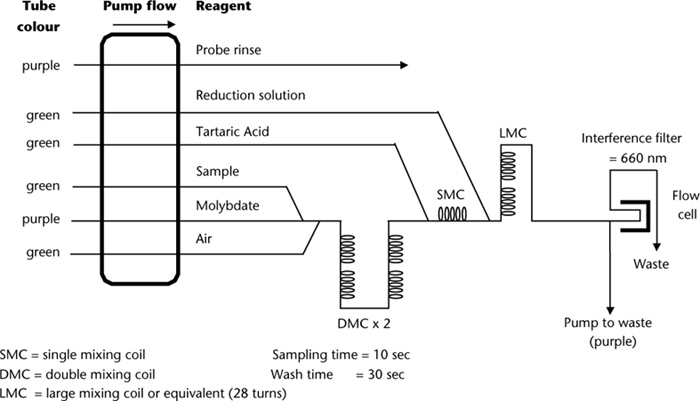
This method uses the same extracting solution (0.005 M H2SO4), soil/solution ratio (1:200) and extraction time (16 h) as Method 9G of Kerr and von Stieglitz (1938). Soluble Si in the clarified extract is determined by a blue silicomolybdous colorimetric finish based on Weaver et al. (1968).
Extraction Solution – 0.005 M Sulfuric Acid
Prepare as for Method 9G1, ensuring the deionised water contains non-detectable residues of soluble Si. This solution of 0.005 M H2SO4 is stable for long periods if kept free of dust and chemical contamination. Equilibrate to 22–25°C prior to use and store in a covered plastic container.
Wetting Agent – Brij 35
Prepare as for Method 5A2a.
Ammonium Molybdate Reagent
Conc. Ammonium Molybdate Reagent: Dissolve 37.5 g ammonium molybdate [(NH4)6Mo7O24.4H2O] in ≈ 400 mL metal-distilled (preferred) or Si-free deionised water. Add sufficient (≈15 mL) ammonium hydroxide solution (NH4OH; ≈27% NH3) to bring to pH to 7.0, then make volume to 500 mL. Store in a plastic bottle.
For use, dilute 50 mL of Conc. Ammonium Molybdate Reagent to 400 mL with metal-distilled (preferred) or Si-free deionised water, add 3 mL of 18 M H2SO4, mix and make volume to 500 mL. Store in a plastic bottle.
Tartaric Acid Reagent
Conc. Tartaric Acid Reagent: Dissolve 50 g (+) tartaric acid [(CHCH.COOH)2] in 400 mL metal-distilled (preferred) or Si-free deionised water, then make to 500 mL.
For use, dilute 50 mL Conc. Tartaric Acid Reagent to ≈450 mL with metal-distilled (preferred) or Si-free deionised water, add 6 drops Brij 35 Wetting Agent, mix, then make to 500 mL. Store in plastic.
Reducing Solution
Conc. Reducing Solution: Dissolve 3.5 g sodium sulfite (Na2SO3) in 50 mL metal-distilled (preferred) or Si-free deionised water. Add 0.75 g of 1-amino-2-napthol-4-sulfonic acid; {ANSA–[NH2.C10H5(OH).SO3H]} and stir to dissolve. Next dissolve 45 g sodium bisulfite (NaHSO3; also called sodium hydrogen sulfite) in 300 mL deionised water then add the ANSA/sulfite solution. Store in plastic, discarding this stock reagent if/when the solution turns yellow.
For use, dilute 50 mL of Conc. Reducing Solution to 500 mL with metal-distilled (preferred) or Si-free deionised water. This working solution is stable for around 48 h.
Select a P Working Standard (see Method 9G1) containing the equivalent of 50 mg P/kg for use as a test to ensure there is no positive interference from soluble P during blue silicomolybdous colorimetric analysis.
Silica Primary Standard
1 L contains 1000 mg Si.
Prepare from a certified commercial standard. Alternatively, prepare as for the Si component of the Combined Fe, Al and Si Primary Standard of Method 13A1. Store in a teflon or a poly reagent bottle. Add a few drops of toluene (C6H5CH3) as preservative.
Silica Secondary Standard
1 L contains 100 mg Si.
Pipette 50 mL Si Primary Standard and dilute with extracting solution (0.005 M H2SO4) to 500 mL in a volumetric flask. This solution should be freshly prepared each time working standards are made.
Silica Working Standards
Add using a micro-burette 0.5, 1.0, 2.0, 4.0, 6.0, 8.0, and 10.0 mL of Si Secondary Standard into separate 200 mL volumetric flasks, mix and make to mark with extracting solution (0.005 M H2SO4). These Si Working Standards contain 0.25, 0.5, 1.0, 2.0, 3.0, 4.0 and 5.0 mg Si/L. For a 1:200 soil/solution ratio, these correspond to soil concentrations of 50, 100, 200, 400, 600, 800, and 1000 mg Si/kg. Store these Working Standards in teflon or poly reagent bottles.
Weigh 1.0 ± 0.01 g of air-dry soil (<2 mm) into 250 mL plastic extracting bottles and add 200 mL extracting solution (0.005 M H2SO4), stopper and mechanically shake end-over-end for 16 h at 22–25°C. Alternatively, weigh 2.5 g of air-dry soil (<2 mm) into 750 mL bottles, add 500 mL of extracting solution (0.005 M) and mechanically shake as above. After extraction, centrifuge or filter (Whatman No. 42 or No. 50 paper), discarding the first portion.
The colorimetric ‘finish’ can be undertaken by continuous SFA (see Figure 13.1) or by FIA.
It is important to assemble the colorimetric manifold in accord with the manufacturer’s instructions. This could require changes to the flow diagram provided for this method. When setting up the flow manifold, check using the P Interference Test Solution that there is no positive analytical interference from P. An appropriate range of Si Working Standards should be analysed (wavelength of 660 nm) at commencement and at regular intervals, using 0.005 M H2SO4 Extracting Solution as the reagent blank and for the probe wash. Determine Si concentrations from a calibration curve (or regression equation).
Report the results as mg Si/kg on an air-dry soil basis.
Figure 13.1 A continuous, segmented flow sheet (AutoAnalyzer 1 technology) for acid-extractable Si.